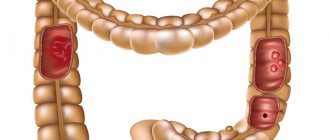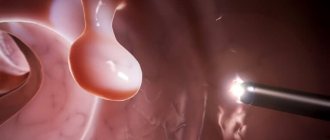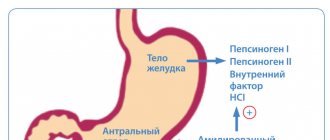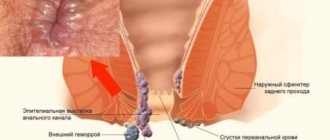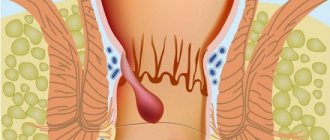The anus is the opening through which feces leave the rectum. In the anus, there is an orifice (the opening itself) and an anal canal - a small area that is located below the rectum. Malignant tumors in this area are rare.
- Causes and risk factors for anal cancer
- Classification of anal cancer
- Stages of anal cancer
- Symptoms
- Diagnostic methods
- Anal cancer treatment
- Radiation therapy for anal cancer
- Chemotherapy
- Survival prognosis
Causes and risk factors for anal cancer
The main cause leading to the development of anal cancer is considered to be HPV - human papillomavirus. HPV infection occurs in 9 out of 10 patients with anal cancer.
Risk factors also include:
- HIV infection;
- immunosuppressive conditions, for example, after organ transplantation;
- homosexuality;
- anal sex;
- frequent change of sexual partners;
- smoking.
Cervical cancer is not a risk factor, but often accompanies anal cancer, as it can also be a consequence of HPV infection.
Signs of Anal Cancer
The first symptoms of anal cancer are easily confused with other diseases of the rectum, for example, hemorrhoids, so patients often do not realize the full danger of the disease and do not consult a doctor in a timely manner.
Symptoms to be wary of:
- sensation of a foreign body in the anus;
- pain in the anal area;
- itching and burning in the anus;
- drops of blood after bowel movements or in stool;
- anal bleeding.
As the disease progresses, maceration (wetting) in the anus is observed, ulcerations appear, and the inguinal and perianal lymph nodes become enlarged. In advanced stages, when the anal sphincter is involved in the process, fecal incontinence develops. Also, women can develop rectovaginal fistulas, and when anal cancer grows into the urethra and prostate in men, urinary disorders can occur. The general condition suffers - the patient loses appetite, loses weight, and becomes weak.
You should seek medical help when the first symptoms of anal cancer appear in order to make a correct diagnosis and begin treatment on time.
Symptoms
Anal cancer can go on for a long time without any symptoms. When symptoms appear, many patients believe that it is hemorrhoids, do not go to doctors, and are treated with traditional methods. I am concerned about bleeding from the rectum, itching, and there is a “lump” in the anus that is in the way. The stool becomes pencil thin because the tumor partially blocks the intestinal lumen. Most often, these manifestations actually indicate hemorrhoids or another benign process. But there is always a risk of a malignant tumor, so you need to visit a doctor as soon as possible and get checked.
Classification of the disease
In most cases (70-80%) anal tumors are squamous cell carcinoma. Adenocarcinoma develops in 10-15% of cases, other tumors account for no more than 3-5%.
In turn, squamous cell (cloacogenic) cancer is divided into:
- large cell non-keratinizing;
- large cell keratinizing;
- basaloid.
Adenocarcinoma of the anal canal can be of the intestinal type, and also develop from the anal glands and rectal fistula.
Rare types of anal cancer include:
- small cell carcinoma;
- poorly differentiated cancer;
- neuroendocrine tumors;
- melanoma of the anal canal;
- non-epithelial tumors;
- unclassified neoplasms;
- secondary tumors.
Stages of anal cancer
To stage cancer, the TNM classification is used, in which T is the size of the tumor, N is the condition of the regional lymph nodes, M is the presence of distant metastases.
TNM classification
| Tumor size | ||
| T | Tx | there is no way to evaluate the primary tumor |
| T0 | no signs of a primary tumor | |
| Tis | cancer in situ | |
| T1 | less than 2 cm | |
| T2 | from 2 to 5 cm | |
| T3 | more than 5 cm | |
| T4 | any size, the tumor grows into neighboring organs | |
| Regional lymph nodes | ||
| N | Nx | it is not possible to evaluate regional lymph nodes |
| N0 | there are no metastases in regional lymph nodes | |
| N1 | there are metastases in perirectal lymph nodes | |
| N2 | metastasis to the unilateral internal iliac and/or inguinal nodes | |
| N3 | metastases are determined in the perirectal and inguinal lymph nodes and/or bilateral internal iliac and/or inguinal lymph nodes | |
| Distant metastases | ||
| M | Mx | there is no way to assess the presence of distant metastases |
| M0 | none | |
| M1 | present | |
Clinical staging
In addition, there is clinical staging based on the most significant component of the TNM classification. According to him, the following stages of the disease are distinguished:
- 0 – tumor in situ, no involvement of regional lymph nodes or distant metastases;
- I – tumor up to 2 cm, no metastases in regional lymph nodes and distant organs;
- II – tumor from 2 to 5 cm or more than 5 cm, without damage to regional lymph nodes and distant metastases;
- IIIA – tumor less than 2 cm, from 2 to 5 cm, more than 5 cm, regional lymph nodes are affected, there are no distant metastases, or a tumor of any size with invasion of nearby organs and tissues without affecting regional lymph nodes and distant metastases;
- IIIB – tumor less than 2 cm, from 2 to 5 cm, more than 5 cm, regional lymph nodes affected at the N2-3 level, or a tumor of any size with invasion into nearby organs and tissues and damage to regional lymph nodes at stage N1;
- IV – distant metastases are present with any size of the primary tumor or its absence/impossibility to assess, and with any degree of involvement (its absence) of regional lymph nodes.
Anal itching - causes
Many people wonder why there is itching in the anus. Below are the main and most common causes of itching in the anus, which can cause discomfort for people of all ages.
Anal itching after defecation can occur due to insufficient hygiene in the anus, which naturally leads to such an unpleasant burning sensation.
Periodic itching in the anus in older people is a fairly common complaint, which is explained by the consequence of natural dry skin. Itching in the anus may appear for the same reason in case of dehydration.
Another common cause of itching in the anal area is increased moisture in the anal area. This condition is typical for people with excessive sweating, and also occurs in people suffering from frequent diarrhea or fecal incontinence.
There are other everyday causes that can lead to itching and burning of the anus. Constant use of a hard washcloth, rough toilet paper, caustic detergents or difficult-to-rinse soap - all this can lead to such an unpleasant consequence as itching in the anus.
The use of certain medications, including certain types of antihemorrhoidal drugs, topical gels and ointments, and birth control suppositories, can also cause discomfort.
Eating certain types of food sometimes causes anal itching; lovers of hot, spicy foods mostly suffer from this. The components included in such products can cause irritation of the mucous membrane.
The most common cause of frequent and short-term itching in the anus is insufficient hygiene in the anus. Which naturally leads to skin irritation in this area.
In rare cases, mild itching in the anus may be a result of hair removal in that area.
There are a number of diseases that are accompanied by anal itching of varying intensity:
- Proctological diseases: sphincteritis, proctitis, anal fissure, hemorrhoids
- Gynecological diseases: inflammation of the external genitalia
- Viral infections: genital warts
- Fungal diseases: thrush, actinomycosis
- Dermatological diseases: seborrhea, lichen planus, inflammation of the sweat glands, psoriasis, atopic eczema)
- Diseases associated with metabolic disorders (pancreatitis, liver failure, diabetes mellitus, etc.)
- Other diseases: bacterial, helminthic infestations, pubic lice, scabies;
In addition, itching in the anus can be a consequence of neurosis or result from the use of certain medications.
There are cases when it is not possible to identify the cause of itching in the anus, then they talk about idiopathic itching, which is caused by a decrease in the contractile function of the sphincter and the secretion of mucus from the rectum, which leads to irritation of the skin around the anus.
It is worth noting that there is such a disease as chronic proctosigmoiditis, the course of which can be secretive. In this case, the only clinical symptom will be redness and itching of the anus. The occurrence of anal itching in this case occurs as a result of a sharp change in the acid-base balance of the sigmoid and rectum, as well as the presence of proteolytic enzymes in the feces, which leads to an increase in the amount of residual nitrogen in the perianal zone, which has an irritating effect on nerve receptors.
Many people have a question, what are the symptoms of anal itching? Usually the only manifestation of this disease is itching around the anus. If you do not pay proper attention to pain and itching, abrasions and scratches can form in the anus, subsequently the skin in this area becomes thinner and becomes susceptible to damage. Microtraumas can lead to infection of the body. Anal itching often occurs in the evening or at night, and thereby provokes insomnia.
There are two main types of anal itching, which are classified depending on the course of the disease.
Acute and severe anal itching mainly appears suddenly and is intense, while in the anus there is moistening of the skin, which leads to additional irritation.
The course of chronic anal itching is characterized by slow development with a gradual increase in discomfort. In this case, as a rule, the skin in the anus area is prone to dryness.
Diagnosis of anal cancer
When a patient first approaches, the doctor collects an anamnesis of life and illness and conducts an initial examination. The doctor will find out whether the patient has a family history of cancer, what concomitant pathologies he suffers from, how long ago the symptoms for which the patient is seeking treatment appeared, and will ask to describe the complaints in detail.
The initial examination includes:
- general examination – height, weight, skin, mucous membranes, lymph nodes;
- examination of the perianal area - the presence of tumor growths on the skin, fistulas, weeping areas, ulcers;
- palpation of the inguinal lymph nodes - their consistency, enlargement, adhesion to each other and to the underlying tissues;
- digital examination of the rectum - clarification of the presence, location, size of the tumor;
- for women - examination by a gynecologist to exclude the spread of the process to the back wall of the vagina, screening for cervical cancer (Pap smear).
The examination plan also includes tests and instrumental studies. These include:
- detailed clinical and biochemical blood test;
- blood test for tumor markers (the types of tumor markers required are determined by the doctor depending on the suspicion of a particular tumor);
- electrocardiography;
- X-ray or computed tomography of the chest;
- Ultrasound or CT with intravenous contrast of the abdominal organs;
- endoanal ultrasound (using a thin probe about 30 cm long) or MRI of the pelvic organs, which evaluates the size of the tumor, the depth of its germination, involvement of the anal sphincter in the process, changes in the perirectal lymph nodes;
- colonoscopy with biopsy and further examination of biopsy material;
- if necessary, biopsy of inguinal lymph nodes.
Diagnostic methods
If anal cancer is suspected, the doctor conducts an examination, a digital examination, and then an endoscopic examination: anoscopy or sigmoidoscopy. If a pathological formation is detected on the mucous membrane, the doctor will perform a biopsy: remove a fragment of suspicious tissue and send it to the laboratory for histological and cytological examination.
To assess the stage of cancer, additional diagnostic methods are used: ultrasound, MRI, CT, PET scan, chest x-ray (to look for metastases in the lungs). Is it possible to detect anal cancer at an early stage? There are screening studies, but they are recommended only for people at high risk:
- with precancerous changes in the anus;
- in homosexuals;
- for anal warts (HPV);
- in women who have had cancer of the vulva, cervix;
- in HIV-infected people and after organ transplantation.
Digital examination of the rectum and cytological analysis help to detect a malignant tumor in the early stages. Sometimes a tumor is discovered by chance when the patient was initially treated for hemorrhoids. Anal cancer rarely metastasizes, and most often it can be successfully treated.
Treatment of anal cancer
Treatment tactics are developed taking into account several factors: the type and size of the tumor, the stage of its detection, the size of the affected part of the anus, the depth of penetration of the tumor, the presence or absence of metastases, damage to the lymph nodes, age, general condition of the patient, and the presence of concomitant diseases.
For treatment, one of the methods or a combination of them can be used:
- excision within healthy tissue or laser ablation (not all clinics practice);
- radiation or radiotherapy;
- chemotherapy;
- extensive surgery;
- palliative therapy.
The standard of treatment is radiation or combined chemoradiotherapy of the tumor and inguinal lymph nodes. Squamous cell carcinoma of the anal canal has high radiosensitivity, so the use of radiation therapy makes it possible to eliminate the tumor and at the same time preserve the obturator function of the anal sphincter.
In addition to radiation therapy, chemotherapy may be prescribed with drugs in tablet form or by intravenous administration. Chemotherapy, in addition to directly affecting the tumor, affects metastases in the inguinal lymph nodes, but has many side effects and is difficult to tolerate by patients.
Radiation therapy is also indicated for recurrent tumors in the pelvic lymph nodes (if it has not been performed previously). If radiotherapy in such a situation is ineffective, lymph node dissection is performed - removal of the lymph nodes along with the tumor and subcutaneous tissue at the site of its formation.
In the early stages, with carcinoma in situ, local excision of the tumor within healthy tissue is possible, without affecting the sphincter.
Extended surgical intervention is indicated for patients with morphologically verified tumor recurrence or its continued growth after chemoradiotherapy. It is carried out no earlier than 24 weeks after completion of chemoradiotherapy. In such cases, abdominal-perineal extirpation of the rectum is performed with a colostomy on the anterior abdominal wall.
Radiation therapy for anal cancer
Typically, radiation therapy sessions are carried out 5 days a week, the course of treatment lasts about five weeks. It is important to correctly direct the radiation to the tumor area so that it minimally affects healthy tissue. Before starting radiation, careful planning is carried out, MRI, PET/CT helps with this. Currently, modern techniques such as 3D conformal radiation therapy and intensively modulated radiation therapy are used.
If the tumor responds poorly to radiation therapy, treatment is supplemented with brachytherapy - a miniature radiation source is placed inside or near the tumor. This helps deliver a larger dose without the risk of damaging healthy tissue. The main indications for radiation therapy for anal cancer:
- As a primary treatment, in combination with chemotherapy.
- Tumor recurrence in the lymph nodes after treatment.
- After surgery to prevent the risk of relapse.
- As part of palliative treatment for cancer with metastases.
Disease prognosis
The prognosis of survival for anal cancer largely depends on the stage at which the tumor is detected, as well as the involvement of regional lymph nodes in the process. The histological form of the tumor affects survival to a lesser extent.
When a tumor with a diameter of less than 3 cm is detected and chemoradiotherapy is administered in a timely manner, cure is achieved in 80% of patients, while relapses occur in less than 10%.
Surgical treatment allows you to achieve stable remission: a five-year survival rate of 55-70% of patients in the absence of metastases in regional lymph nodes, 20% - if they are present.
It was noted that the prognosis is worse for men, and the disease is more severe and has a worse prognosis in smokers and those infected with HIV.
Survival prognosis
Anal cancer has a fairly high five-year survival rate. If treatment is started at the first stage, 71-77% of patients remain alive within 5 years, at the second stage - 59-67%, at the third - 35-58%. Metastases are rarely detected, but if they are present, the prognosis worsens sharply. This type of cancer is difficult to treat. The five-year survival rate for such patients is 7–15%.
| More information about treatment at Euroonco: | |
| Proctologist-oncologist | RUB 5,100 |
| Chemotherapy appointment | RUB 6,900 |
| Emergency oncology care | from 12,100 rub. |
| Palliative care in Moscow | from 44,300 rubles per day |
| Radiologist consultation | RUB 11,500 |
Book a consultation 24 hours a day
+7+7+78
Prevention of anal cancer
To prevent the occurrence of anal cancer, you should first of all observe sexual hygiene - avoid frequent changes of sexual partners, use condoms, do not practice anal sex, periodically be examined for the presence of sexually transmitted infections, and promptly treat them if detected.
A healthy lifestyle, giving up alcohol and smoking, and supporting the immune system will be useful in the prevention of any diseases, including malignant tumors.
If you detect any suspicious symptoms - pain in the anus, mucous or bloody discharge, feeling of a foreign body - you should contact a proctologist. An annual colonoscopy for preventive purposes is recommended annually for all people over 45 years of age.
After treatment for anal cancer, patients are under the supervision of a proctologist or oncologist. In the first 1-2 years, it is recommended to visit a doctor who will determine the required scope of examination every 3-6 months. During the period of 3-5 years - 1-2 times a year. After 5 years from the date of treatment, annual consultations with a doctor or contacting a doctor if complaints arise.
Information verified by an expert
Mikhailov Alexey Gennadievich operating oncologist, doctor of the highest qualification category, Ph.D. experience: 21 years
The information in this article is provided for reference purposes and does not replace advice from a qualified professional. Don't self-medicate! At the first signs of illness, you should consult a doctor.
Hypertrophied anal papillae. Treatment of inflammation of the anal papillae
Inflamed anal papillae, papillitis, fibroanal polyps are an acute or chronic proctological disease characterized by pain, intense itching in the anus, sensation of a foreign object, discomfort and difficulty during defecation, sphincter spasm. The cause of inflammation is hypertrophied anal papillae (papillae) - anatomical nodular intraluminal formations at the level of the anorectal line, normally not exceeding 1 cm and having a pale pink color. Under normal conditions, a proctologist can detect them next to the Morganian crypts during palpation of the anorectal area.
Papillae are classified into two types based on their shape:
- cone-shaped with a wide base;
- spherical on a narrow stalk.
Cause and symptoms of papillitis
Problems begin when the formations become inflamed, multiply in size, and acquire a red-purple hue. At the initial stage of the disease, discomfort occurs only during bowel movements. When the disease progresses for a long time, the inflamed anal papillae may even protrude from the rectum, which significantly aggravates the problem. Also, when they grow up to 3 cm, they may be pinched by the sphincter muscles, which is accompanied by acute pain spreading to the coccyx area.
The initiation of the inflammatory process occurs at the time of frequent mechanical injury to the papillae from feces and penetration of infection into the tissue, which is typical for chronic constipation. Another way is possible, when the papillae are irritated under the influence of toxins eliminated by the body after poisoning.
Patients report the following symptoms:
- “foreign body” in the anus;
- pain that gets worse with bowel movements;
- burning and swelling at the base of the anus;
- formation of erosions;
- traces of blood;
- the appearance of mucus from the anus due to weakening of the sphincter function.
Provoking factors for inflammation of the anal papilla include:
- inactive lifestyle and poor circulation in the pelvis, including obesity and pregnancy;
- regular constipation and trauma to the rectal mucosa;
- food poisoning;
- abuse of cleansing enemas;
- allergies to the composition of linen, personal hygiene products;
- excessive alcohol consumption;
- proctological diseases (cryptitis, hemorrhoids, proctitis).
Diagnostic features
Hypertrophy of the anal papillae and the development of the inflammatory process are easily detected by a proctologist when examining the rectal area. The nature of the patient’s complaints is of great importance, since papillitis can manifest itself against the background of other problems. The peculiarity of the diagnosis is that enlarged anal papillae are similar in shape to tumor-like growths in rectal polyposis. They can also be confused with the so-called sentinel tubercle (a sign of chronic anal fissure) or hemorrhoidal node. In this regard, to make an accurate diagnosis, a detailed examination with mirrors can be performed, and anoscopy can also be prescribed.
Differences between hypertrophied anal papillae (papillitis) and polyposis:
- the papillae are externally pale, covered with multilayered squamous epithelial tissue;
- polyps in one layer are covered with columnar epithelium to match the color of the mucous membrane;
- papillae are located approximately at the level of the anorectal line;
- Rectal polyps are always localized above the anorectal level.
If during a routine examination the proctologist discovered papillae in you, you should not panic - this is normal if their appearance and location do not go beyond the norm. If they give you anxiety, have signs of inflammation or fall out of the rectum, then the need to remove the hypertrophied anal papillae is obvious. This must be done so that one trouble is not joined by others, more serious and potentially dangerous. In some situations, a histological examination may be required, when a piece of tissue is sent to the laboratory to be analyzed for malignant degeneration.
Treatment of inflammation and hypertrophy of anal papillae
Modern proctology uses two types of treatment: medication and surgery. When choosing a tactic, the attending physician does not rely on the fact of the presence of hypertrophied papillae, but on the cause of their inflammation. So, if the formations are inflamed against the background of hemorrhoids, then it should be treated first, and if they are accompanied by proctitis, then the treatment of proctitis is paramount. As clinical practice shows, when diagnosing a chronic anal fissure (fissure), removal of the anal papillae is considered a strict necessity.
Drug treatment
For isolated inflammation of the anal papillae, treatment with medications is successful. As part of therapy, the following are prescribed:
- special diet;
- warm baths, enemas with antiseptic, astringent, bacteriostatic effects;
- anti-inflammatory suppositories;
- antibacterial therapy.
Surgery to excise hypertrophied anal papillae is indicated in rare cases. Removal is recommended if drug treatment does not bring results, the papillae are large in size, the anal papillae constantly fall out of the anus, their surface is covered with ulcers. Surgery is also necessary when the development of papillitis occurs against the background of another disease of the anorectal mucosa.
Surgical treatment regimen for hypertrophied anal papillae
Two modern methods of surgical intervention are considered the most successful:
- surgery using the Gabriel method - the surgeon excises the anal papilla along with the adjacent crypt;
- cryodestruction of inflamed papillae is a minimally invasive operation using liquid nitrogen to remove the anal papilla.
The surgical intervention is performed on an outpatient basis in a specialized proctology setting, under local or intravenous anesthesia.
Forecast
In the majority of patients, after drug treatment of anal papillae, complete regression of symptoms is recorded, so the prognosis of the disease is favorable. Enlargement and inflammation of papillae in themselves do not threaten human life. But it should be understood that with this diagnosis, neither acute nor chronic inflammation of the anal canal structures occurs independently. With complicated papillitis, the prognosis worsens. To prevent the development of paraproctitis, pectenosis and other serious ailments, you need to be examined, determine the nature of the phenomenon and take the necessary measures.
Prevention of papillitis
To prevent relapses that will lead to a new need for surgical treatment of the anal papillae, the patient should:
- carefully care for the perianal area;
- give up “wrong” nutrition, fight constipation;
- promptly identify and treat gastrointestinal diseases;
- give up bad habits and unconventional sex;
- be moderately active, avoid stagnant processes in the pelvis.
After excision of hypertrophied anal papillae and in the absence of pathological neoplasms in the rectum, the patient should undergo an annual follow-up examination.
How to treat anal papillae if they are inflamed
At the initial stage, the disease is asymptomatic or with minimal symptoms. Therefore, in this case, the appearance of regular discomfort indicates that the disease is in full swing. If you suspect that your anal papillae are inflamed, do not engage in amateur activities. This can be fraught with serious health consequences and interfere with further quality of life. If you experience any discomfort, and even more so with pain in the rectum and anal canal, do not hesitate to make an appointment with a doctor. The sooner the diagnosis is made, the easier it is to restore health!
Many are afraid of surgical intervention for complicated hypertrophied anal papillae, having heard enough horror stories. In fact, high-precision, minimally invasive surgical methods are now used, so the risks are minimal compared to the prospects of refusing treatment. If it is important for you that the operation is performed by a male proctologist surgeon, contact the best private proctology in Rostov on the street. 2nd Five-Year Plan, 29/5. Dr. Tolokhyan has more than 20 years of experience in practical medicine, 16 years of experience in proctology/surgery and hundreds of grateful patients.
